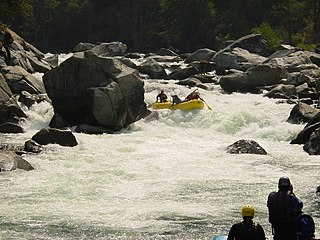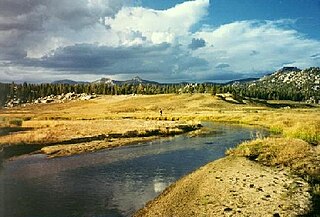| Return Creek | |
| Country | United States |
|---|---|
| State | California |
| Source | Sierra Nevada |
| - elevation | 11,938 ft (3,639 m) |
| - coordinates | 38°04′51″N119°21′18″W / 38.08083°N 119.35500°W [1] |
| Mouth | Tuolumne River |
| - elevation | 6,204 ft (1,891 m) |
| - coordinates | 37°55′55″N119°27′58″W / 37.93194°N 119.46611°W Coordinates: 37°55′55″N119°27′58″W / 37.93194°N 119.46611°W [1] |
| Length | 12.96 mi (21 km) |
Return Creek is a stream in the northeast part of Yosemite National Park, in Tuolumne County, California, and is a tributary of the Tuolumne River. About 13 miles (21 km) in length, it is the first major tributary to join downstream of Tuolumne Meadows. The creek begins at Return Lake on the Sierra Crest, near Virginia Pass, and flows initially east before turning southwest and joining with McCabe Creek and Spiller Creek. On its path to the Tuolumne River the creek has carved out the 2,000-foot (610 m) deep Virginia Canyon, which was enlarged to its present shape by glaciation. After its confluence with Matterhorn Creek it flows south-southwest to its confluence with the Tuolumne River, about a quarter mile (400 m) below Waterwheel Falls. [2]

Yosemite National Park is an American national park located in the western Sierra Nevada of Central California, bounded on the southeast by Sierra National Forest and on the northwest by Stanislaus National Forest. The park is managed by the National Park Service and covers an area of 747,956 acres and sits in four counties: centered in Tuolumne and Mariposa, extending north and east to Mono and south to Madera County. Designated a World Heritage site in 1984, Yosemite is internationally recognized for its granite cliffs, waterfalls, clear streams, giant sequoia groves, lakes, mountains, meadows, glaciers, and biological diversity. Almost 95% of the park is designated wilderness.

California is a state in the Pacific Region of the United States. With 39.6 million residents, California is the most populous U.S. state and the third-largest by area. The state capital is Sacramento. The Greater Los Angeles Area and the San Francisco Bay Area are the nation's second- and fifth-most populous urban regions, with 18.7 million and 9.7 million residents respectively. Los Angeles is California's most populous city, and the country's second-most populous, after New York City. California also has the nation's most populous county, Los Angeles County, and its largest county by area, San Bernardino County. The City and County of San Francisco is both the country's second-most densely populated major city after New York City and the fifth-most densely populated county, behind only four of the five New York City boroughs.

The Tuolumne River flows for 149 miles (240 km) through Central California, from the high Sierra Nevada to join the San Joaquin River in the Central Valley. Originating at over 8,000 feet (2,400 m) above sea level in Yosemite National Park, the Tuolumne drains a rugged watershed of 1,958 square miles (5,070 km2), carving a series of canyons through the western slope of the Sierra. While the upper Tuolumne is a fast-flowing mountain stream, the lower river crosses a broad, fertile and extensively cultivated alluvial plain. Like most other central California rivers, the Tuolumne is dammed multiple times for irrigation and the generation of hydroelectricity.
The Pacific Crest Trail follows part of Virginia Canyon and crosses Return Creek just above the confluence of McCabe Creek. [3]

The Pacific Crest Trail, officially designated as the Pacific Crest National Scenic Trail (PCT) is a long-distance hiking and equestrian trail closely aligned with the highest portion of the Sierra Nevada and Cascade mountain ranges, which lie 100 to 150 miles east of the U.S. Pacific coast. The trail's southern terminus is on the U.S. border with Mexico, just south of Campo, California, and its northern terminus on the Canada–US border on the edge of Manning Park in British Columbia; its corridor through the U.S. is in the states of California, Oregon, and Washington.
Return Creek has also been labeled, on early maps, as the North Fork of the Tuolumne River. [1] This is not to be confused with the actual North Fork Tuolumne River, located much further to the west.

The North Fork Tuolumne River is a 35.7-mile (57.5 km) long river in the central Sierra Nevada of Tuolumne County, California and is a major tributary of the Tuolumne River. It originates above the Dodge Ridge Ski Area about 2 miles (3.2 km) east of Pinecrest, in the Stanislaus National Forest. From there it flows generally southwest, past Long Barn, Twaine Harte, Soulsbyville and Tuolumne. Below Long Barn the river flows through a narrow canyon on its way to join the Tuolumne River, at the head of Lake Don Pedro Reservoir, about 5 miles (8.0 km) north of Groveland.

















